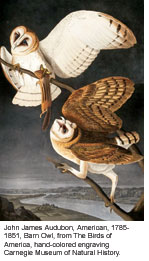Back
A Jurassic Park of fossils
 It’s
been decades since Carnegie Museum of Natural History paleontologists
dug for dinosaur bones in the dusty fossil fields of Wyoming.
But it looks like they’ll be back at it again less
than 30 miles from the site of the museum’s first
and most famous dinosaur find, Diplodocus carnegii, discovered
in 1899. It’s
been decades since Carnegie Museum of Natural History paleontologists
dug for dinosaur bones in the dusty fossil fields of Wyoming.
But it looks like they’ll be back at it again less
than 30 miles from the site of the museum’s first
and most famous dinosaur find, Diplodocus carnegii, discovered
in 1899.
Earlier this year, Wyoming cattle rancher Allen
Cook donated a 4,700-acre piece of his 120,000-acre Wyoming
cattle ranch
to the University of Pittsburgh—a “remarkable” gift,
says Alec Stewart, dean of the Pitt honors program, given
the fact that Cook had no previous connections to Pitt.
A college friend of Stewart’s happened to be the
land economist who appraised the land for Cook and made
him aware of just how valuable its contents were to the
scientific community. He and Stewart became instrumental
in making the unusual land gift a reality.
Because of Pitt’s
close ties with Carnegie Museum of Natural History, the
gift will benefit the museum as
well. Pitt, the University of Wyoming, and the museum will
all be partners in the exploration and study of the site,
and fossils found on the land will eventually join Carnegie
Museums’ world-renowned collection.
This field of
dreams is practically “littered” with
fossils, according to Curator Emeritus Mary Dawson, who
visited the ranch several years ago. It’s also rich
with American Indian artifacts and interesting geological
features, and it intersects with parts of the famed Morrison
Formations that produced Diplodocus carnegii more than
100 years ago.
Staff members from the museum and the University
of Pittsburgh are visiting the site in June to begin
planning its future.
One possibility: They might one day open it to members
of the general public who, under museum guidance, could
sign up to be part
of supervised digs. Dig that!
In the name of science—and Bill and
Ingrid Rea
 On
May 10, at a board meeting of the Heinz Endowments, board
members surprised their colleague, Bill Rea, when they
announced that they had made a special $2 million gift
to Carnegie Museum of Natural History and Powdermill Nature
Reserve in honor of Rea and his late wife, Ingrid. Also
present was Bill DeWalt, director of Carnegie Museum of
Natural History, who announced that the gift would support
the creation of two new positions: the Bill and Ingrid
Rea Curator of Conservation Biology, which will be based
at Powdermill, and the Bill and Ingrid Rea Curator of Amphibians
and Reptiles, which will be based at the museum. Sadly,
less than a week after this touching event, Rea passed
away at the age of 94. On
May 10, at a board meeting of the Heinz Endowments, board
members surprised their colleague, Bill Rea, when they
announced that they had made a special $2 million gift
to Carnegie Museum of Natural History and Powdermill Nature
Reserve in honor of Rea and his late wife, Ingrid. Also
present was Bill DeWalt, director of Carnegie Museum of
Natural History, who announced that the gift would support
the creation of two new positions: the Bill and Ingrid
Rea Curator of Conservation Biology, which will be based
at Powdermill, and the Bill and Ingrid Rea Curator of Amphibians
and Reptiles, which will be based at the museum. Sadly,
less than a week after this touching event, Rea passed
away at the age of 94.
Ingrid Rea was a Life Trustee of
Carnegie Museums of Pittsburgh and served on the board
of Carnegie Museum of Natural History.
Bill was instrumental in the merger of the Buhl Science
Center with Carnegie Museums of Pittsburgh and was a great
supporter of Carnegie Science Center and served on its
board. Together, they had a profound effect on conservation,
education, and research through their stewardship of their
beloved Stonylonesome Farm in the Laurel Highlands and
the work of neighboring Powdermill Nature Reserve, Carnegie
Museum of Natural History’s 2,200-acre biological
field station in Rector, Pa.
“
Gentility, grace, a genuine concern for making a difference,
and enlightened civic leadership: These are all qualities
that are all too rare in today’s world, but they
were exemplified by Bill and Ingrid Rea’s contributions
to Carnegie Museums,” said DeWalt. “This grant
from the Howard Heinz and Vira Heinz Endowments will enable
us to bring the quality of the research at Powdermill up
to the same world-class standard of research that exists
at the museum,” he added. “And naming these
curatorial positions for Bill and Ingrid Rea will perpetuate
their great legacy.”
“
We at the Heinz Endowments are grateful to have had a chance
to recognize the extraordinary contributions that Bill
Rea has made over three decades to the foundation, to Pittsburgh,
and the region,” said Teresa Heinz, who chairs the
Howard Heinz Endowment and the Heinz Family Philanthropies. “He
honored all of us with his thoughtful contributions. For
me, personally, for the Heinz family, and for the Endowments,
he leaves us with a warm memory in our hearts and a gutsy,
joyful attitude in our work.”
You’ve got
a (fierce) friend in Pennsylvania
 As
guests gathered on Friday, March 24, for a VIP reception
in honor of the weekend opening of Fierce Friends:
Artists and Animals, 1750-1900, official word arrived that Pennsylvania
Governor Ed Rendell had awarded $200,000 to Carnegie Museum
of Art in support of the exhibition. The grant was made
through the state’s Department of Community and Economic
Development (DCED). At the same time, the state awarded
$100,000 to Pittsburgh Roars, the regional celebration
of western Pennsylvania’s many attractions that was
conceived when Fierce Friends was still in the planning
stages. As
guests gathered on Friday, March 24, for a VIP reception
in honor of the weekend opening of Fierce Friends:
Artists and Animals, 1750-1900, official word arrived that Pennsylvania
Governor Ed Rendell had awarded $200,000 to Carnegie Museum
of Art in support of the exhibition. The grant was made
through the state’s Department of Community and Economic
Development (DCED). At the same time, the state awarded
$100,000 to Pittsburgh Roars, the regional celebration
of western Pennsylvania’s many attractions that was
conceived when Fierce Friends was still in the planning
stages.
“
Tonight, we celebrate the extraordinary accomplishments
of those responsible for making Fierce Friends possible,” said
Carnegie Museums President David Hillenbrand, as he addressed
the gathering. “This includes you, the friends and
supporters of our four wonderful museums here this evening.
And it also includes the governor of this great state,
who we thank for his strong and very generous endorsement.”
Sailors tell their tales on the USS Requin
 “Sailors
are great storytellers,” says Patty Rogers, Carnegie Science Center’s
coordinator of historic exhibits, “and it’s so much more engaging
to hear their stories than just read them.” And now, visitors to the
Science Center’s World War II-era submarine, the USS Requin, will be
able to do just that, thanks to a collaboration between the Science Center
and Carnegie Mellon University’s Entertainment Technology Center (ETC). “Sailors
are great storytellers,” says Patty Rogers, Carnegie Science Center’s
coordinator of historic exhibits, “and it’s so much more engaging
to hear their stories than just read them.” And now, visitors to the
Science Center’s World War II-era submarine, the USS Requin, will be
able to do just that, thanks to a collaboration between the Science Center
and Carnegie Mellon University’s Entertainment Technology Center (ETC).
Dubbed “Living History,” the project brings to life the sights
and sounds—and voices—of the 1960’s sub through a number
of interactive displays created by ETC graduate students. “We’re
so happy to share some of the great Requin stories in a way that makes
submarine life real for our visitors,” says Rogers.
Some of those
stories were recorded at a Requin crew reunion held at the Science Center
in 2004. Others were retrieved by ETC students who interviewed
former crewmates especially for this project. As visitors tour the submarine,
they’ll see and hear actual Requin veterans recounting heartwarming,
sometimes funny stories of life on the sub; they’ll actually hear
the floor rumble at the launch of a torpedo, or ice scraping along the
hull during
an Arctic exploration; and they’ll hear the chatter of the crew
and the commands of the ship’s officer.
The ETC grad students are
a combination of technologists and fine artists who worked closely
with Science Center staff to develop the touch-screen
content,
which provides information about the Requin and submarines in general,
for six of Requin’s compartments: the forward torpedo room, control
room, mess deck, berthing compartment, and two engine rooms. There’s
even a special kid’s area accessible from the screens’ main
menu.
The Requin is open everyday for self-guided tours throughout the
summer.
Honoring Suzy Broadhurst
 What
do you give a person who has everything? If she’s
someone who loves giving to others, you give her something
that will help her do more of that. What
do you give a person who has everything? If she’s
someone who loves giving to others, you give her something
that will help her do more of that.
On March 9, that’s
what the Carnegie Museums of Pittsburgh Board of Trustees
did to honor its chair, Suzy Broadhurst,
who also served as interim president for one year until
David Hillenbrand became Carnegie Museums’ new president
in July 2006. At the March quarterly Trustees Meeting,
Lee Foster, vice chair of the board, announced to Broadhurst
that the board had established a special fund in her honor
to send deserving kids to summer camp at Carnegie Museums
of Art and Natural History and Carnegie Science Center.
Named the Suzanne W. Broadhurst Children’s Camp Fund,
it will cover the cost of tuition at Carnegie Museums summer
camps for a number of children each summer, beginning in
2007.
“
There’s no one more deserving of this kind of recognition
than Suzy Broadhurst,” Lee Foster said, as he presented
Broadhurst with a special framed photograph of children
enjoying an activity at a summer camp. “Suzy has
given so much of her time, energy, and boundless enthusiasm
over the past two years, and through this special fund,
we will be able to honor and thank her for years to come.”.
Shopping
with Andy Warhol

Andy
Warhol and retail: What could be more perfect? When local
developer Eastside Partners was putting the finishing touches
on its new commercial building in East Liberty—the
one that now houses Walgreen’s—its management
thought about art, and then thought about Warhol. Since
the building’s storefront windows were on the
ground floor facing Liberty Avenue, Eastside Partners thought
the space would be a perfect place to display artwork And
what else but the art of the retail-loving Warhol would
make sense?
Knowing that The Andy Warhol Museum has loaned
artwork to other community organizations for display, such
as the
Children’s Museum, Eastside Partners turned to Warhol
Director Tom Sokolowski to see if the museum would be interested
in bringing a little Andy Warhol over to the East End.
Sokolowski says The Warhol is always eager to “embrace
the community” through such initiatives. “This
collaborative art and education project is one way Andy
Warhol's artistic genius can entertain, encourage, and
inspire all passersby to follow their own American dreams,” he
says.
The window displays mix seven Warhol images with
Warhol quotes that suit the setting—such as, “I
like boring things. I like things to be exactly the same
over
and over again.” The innovative program is being
funded by Walgreen's and Eastside's developer, The Mosites
Company.
Back
| Top |